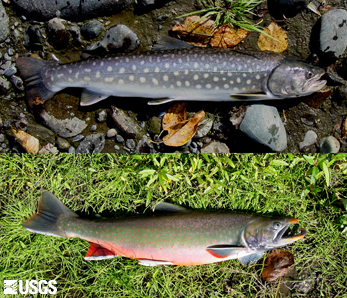- Home
- About S&T
- Taxa/Organisms
- Ecosystems
- Issues
- Methods & Tools
- Reports & Publications
- Location
- Search
Publisher: USGS | Science Center: Western Fisheries Research Center (WFRC, Seattle) | Format: URL
wfrc.usgs.gov — Since 1994, scientists from the Anadromous Fish Ecology Team have been assisting the U.S. Army Corps of Engineers (USACE) in evaluating the migration behavior and passage of juvenile salmon and steelhead through Lower Granite Reservoir and Dam on the Snake River, WA. The goal of this study is to identify the behavior of individual juvenile salmon More...

Publisher: USGS | Science Center: Western Fisheries Research Center (WFRC, Seattle) | Format: URL
wfrc.usgs.gov — The Arctic charr (Salvelinus alpinus) in the northern most latitudes migrate to the ocean in the spring to feed and grow. This results in accumulation of polychlorinated biphenyls (PCB) in their visceral fat. During the winter, the charr reside in freshwater lakes and do not feed. They do mobilize lipids from adipose tissue for energy, which More...

Publisher: USGS | Science Center: Western Fisheries Research Center (WFRC, Seattle) | Format: URL
wfrc.usgs.gov — Over the past 150 years, land reclamation activities have resulted in loss of significant amounts of tidal marshes (sometimes referred to as inter-tidal wetlands, the estuarine zone that is alternately flooded and exposed) in San Francisco Bay and the Sacramento-San Joaquin Delta (Bay/Delta). Recently, in an effort to halt or reverse the decline More...

Publisher: USGS | Science Center: Western Fisheries Research Center (WFRC, Seattle) | Format: URL
wfrc.usgs.gov — In an attempt to decrease pesticide pollution of aquatic ecosystems, we have begun a project to develop biological control agents to protect plants against fungal diseases. This study has three objectives: (1) understanding how fungi cause disease; (2) understanding how plants that are symbiotic with certain fungi are resistant to fungal diseases; More...

Publisher: USGS | Science Center: Western Fisheries Research Center (WFRC, Seattle) | Format: URL
wfrc.usgs.gov — Threatened and endangered salmonids in the Pacific Northwest often use backwaters and wetlands as they migrate toward the ocean, however our understanding of the role of wetlands to juvenile salmonids is limited. The major Objective of this study was to determine whether juvenile steelhead were being tapped on the wetland during spring, and More...

Publisher: USGS | Science Center: Western Fisheries Research Center (WFRC, Seattle) | Format: URL
wfrc.usgs.gov — Ballast water discharges are the most significant cause of aquatic biological invasions in coastal waters, including the Great Lakes. Currently, treatment of ballast water prior to discharge at the receiving port offers significant promise to help control this problem. However, development of treatment technologies is limited by lack of objective More...

Publisher: USGS | Science Center: Western Fisheries Research Center (WFRC, Seattle) | Format: URL
wfrc.usgs.gov — This U.S./Russian collaboration will investigate genetics and life histories of Kamchatka Peninsula rainbow trout and steelhead (O. mykiss), and Dolly Varden, white-spotted, and arctic char (S. malma, S. leucomaensis, and S. alpinus, respectively). Both anadromous and resident forms of these generally occur in Kamchatka rivers that are free from More...

Publisher: USGS (Biological Science Office) | Science Center: Alaska Science Center (ASC, Anchorage) | Format: URL
www.absc.usgs.gov — This project was designed to assess whether or not populations are recovering, whether isolated processes constrain recovery, and the potential activities to facilitate recovery. This web resource provides links to background information on Nearshore Vertebrate Predators, the Sea Otter, the Harlequin Duck, the River Otter, and the Pigeon More...

Publisher: USGS | Science Center: Western Fisheries Research Center (WFRC, Seattle) | Format: URL
wfrc.usgs.gov — Fall chinook salmon (Oncorhynchus tshawytscha) in the Snake River are currently listed as threatened under the Endangered Species Act (ESA). Because fall chinook salmon migrate seaward during the summer when flows are low and water temperatures are high, their survival rate is lower. The goal of this study is to more clearly identify the More...

Publisher: USGS | Science Center: Western Fisheries Research Center (WFRC, Seattle) | Format: URL
wfrc.usgs.gov — As anadromous juvenile salmonids migrate from freshwater rearing habitats to the ocean, they are vulnerable to a host of factors that affect their survival. Direct effects associated with dam passage (e.g., instantaneous mortality, injury, loss of equilibrium, etc.) and indirect effects (e.g., predation, disease, and physiological stress) More...

Publisher: USGS | Science Center: Western Fisheries Research Center (WFRC, Seattle) | Format: URL
wfrc.usgs.gov — As anadromous juvenile salmonids migrate from freshwater rearing habitats to the ocean, they are vulnerable to a host of factors that affect their survival. Direct effects associated with dam passage (e.g., instantaneous mortality, injury, loss of equilibrium, etc.) and indirect effects (e.g., predation, disease, and physiological stress) More...

Publisher: USGS | Science Center: Western Fisheries Research Center (WFRC, Seattle) | Format: URL
wfrc.usgs.gov — This project is a fruitful approach to studying long-term changes in aquatic ecosystems through the use of sediment cores and the various types of indicators that can be extracted from these cores.
